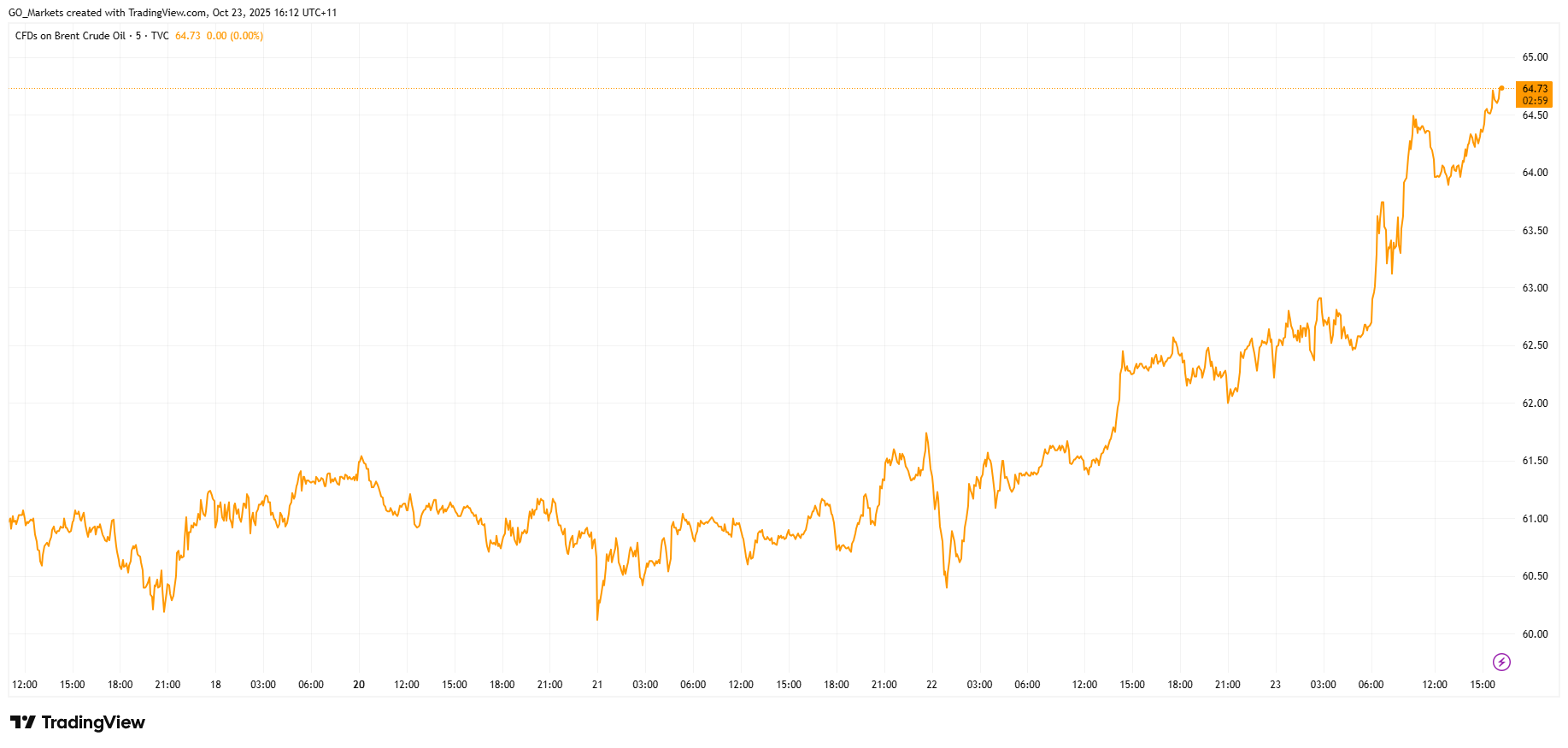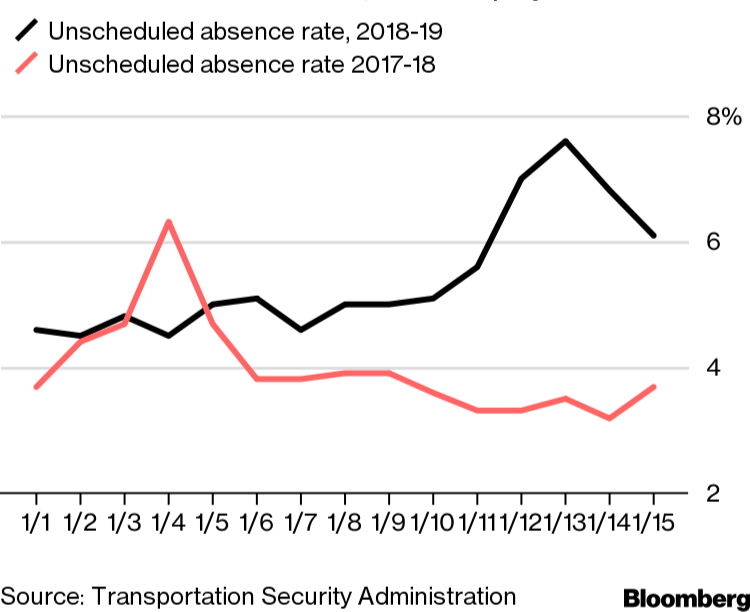Market news & insights
Stay ahead of the markets with expert insights, news, and technical analysis to guide your trading decisions.

New U.S. Sanctions on Russia as Putin Conducts Nuclear Tests
The U.S. has imposed new sanctions on Russia's two largest oil companies, Rosneft and Lukoil, after planned peace talks between Trump and Putin collapsed on Wednesday.
Oil prices spiked 3% after the announcement, with Brent crude hitting $64 per barrel.

The targeted companies are among the world's largest energy exporters, collectively shipping about three million barrels of oil daily and accounting for nearly half of Russian production.
The sanctions build on recent European measures, as the UK targeted the same companies last week and the EU approved its own sanctions package on Wednesday.
In a show of force coinciding with the new sanctions, Putin supervised strategic nuclear exercises on Wednesday involving intercontinental ballistic missile launches from land and submarine platforms.
While the Kremlin emphasised these were routine drills, the highly coincidental timing is notable.
For markets, the key question now is whether secondary sanctions will follow, and if Trump’s enforcement remains strict. Traders will watch closely for any TACO signals that see Trump ease pressure in an attempt to restart negotiations.
Historic PM Wasting No Time on Celebrations
Sanae Takaichi made history this week as Japan's first female Prime Minister. The 64-year-old conservative leader, dubbed the "Iron Lady,” is already rolling out an aggressive policy agenda that could reshape Japan's economic and geopolitical position.
Her first major move is an economic stimulus package expected to exceed US $92 billion. The package includes abolishing the provisional gasoline tax and raising the tax-free income threshold from ¥1.03 million ($6,800), moves designed to put more money in consumers' pockets and battle inflation.

Her next move will come when Trump arrives in Tokyo next week, as the Japanese government is finalising a purchase package including Ford F-150 pickup trucks, US soybeans, and liquefied natural gas as sweeteners for trade talks.
Takaichi has campaigned on being a champion for expansionary fiscal policy, monetary easing, and heavy government investment in strategic sectors, including AI, semiconductors, biotechnology, and defence.
Critical Workers to Miss First Paycheck Due to Shutdown
The U.S. government shutdown is on the verge of creating a crisis for aviation safety, with 60,000 workers set to miss their first full paycheck this week.
These essential workers, who earn an average of $40,000 annually, already saw shortened paychecks last week. By Thursday, many will receive pay stubs showing zero compensation for the coming period, forcing impossible choices between basic necessities and reporting to work.
During the last extended shutdown, TSA sick-call rates tripled by Day 31, causing major delays at checkpoints and reduced air traffic in major hubs like New York — disruptions which are directly attributed to pressuring the end of the previous shutdown.

The National Air Traffic Controllers Association warns that similar pressures are building, with many workers soon to be facing a decision between attending their shift or putting food on the table.


Trading terms glossary A - B - C - D - E - F - G - H - I - J - K - L - M - N - O - P - Q - R - S - T - U - V - W - X - Y - Z - W West Texas Intermediate (WTI) West Texas Intermediate (WTI, also referred to as Texas Light Sweet) is an oil benchmark that is central to oil commodity trading. It is one of the three major oil benchmarks used in trading, along with Brent crude and Dubai/Oman. Working Order A Working Order typically refers to either a stop or limit order to open.
Working Orders are used to advise your broker to execute a trade when your desired tradable asset reaches a specified price. Learn more about Working Orders


Trading terms glossary A - B - C - D - E - F - G - H - I - J - K - L - M - N - O - P - Q - R - S - T - U - V - W - X - Y - Z - V Variable costs Variable cost refers to an expense which is subject to change when a products sales volumes change. Costs will typically increase or decrease when sales drop or rise, respectively. VIX Short for the Chicago Board Options Exchange Volatility Index, the VIX is used to track S&P 500 index volatility.
It is arguably the most well-known volatility index on the market. Learn more about VIX Volatility A market’s volatility is its likelihood of making major, short-term price movements at any time. A high level of volatility can provide opportunity to make profitable trades in a short period of time.
Learn more about Volatility Volume Volume in trading refers to the amount of a particular asset being traded over a certain period of time. It's typically presented alongside price information and offers an extra dimension when examining the price history of an asset. Learn more about using Volume in trading.
Volume-weighted average price VWAP is a technical analysis tool which shows the ratio of an asset's price to its total trade volume. the VWAP provides traders with a measure of the average price a stock has traded at over a given period of time.


Trading terms glossary A - B - C - D - E - F - G - H - I - J - K - L - M - N - O - P - Q - R - S - T - U - V - W - X - Y - Z - U Unborrowable stock The stock that no one is willing to lend out to short sellers is known as an Unborrowable stock. The traditional means of short selling is impossible, when shares in a company are unborrowable.


Trading terms glossary A - B - C - D - E - F - G - H - I - J - K - L - M - N - O - P - Q - R - S - T - U - V - W - X - Y - Z - T Take profit (TP) Learn more about Trading with a Profit Target (Take Profit) Strategy. Tangible assets Tangible assets are a companies physical assets, such as real estate holdings, machinery, manufacturing or computer equipment, and raw materials of value, e.g. timber, ore, etc. Technical analysis Technical analysis is the examination and prediction of price movements in a financial market.
Analysts aim to form accurate predictions of future price movements using information such as historical data, market statistics, trader sentiments and current events impacting a given market. Tom-next Short for ‘tomorrow-next day’, Tom-next is the process of rolling a Forex position from one spot day to the next. This is also sometimes referred to as "the cost of carry" or "financing adjustment".
Trading floor Also referred to as a "trading pit", the trading floor is the area in an exchange where assets are traded. This is most commonly associated with stock and futures exchanges. Trading journal Learn more about using a Trading Journal.
Trading plan A strategy used by individual traders to evaluate assets, risk management and types of tradings. A trading plan will typically be composed of the expected term of trading, and how to accomplish the traders objectives in that time frame. Learn more about Trading Plan Trailing stop A trailing stop is modified type of stop-loss order that automatically follows positive market movements of traders asset.
If the traders position moves positively but then reverses, a trailing stop will lock in the current profit and close the traders position. Learn more about using a Trailing Stop strategy. Treasury stock Treasury stocks are a portion of a company’s shares that it keeps in its own treasury.
These shares do not pay dividends - because a company can't pay itself - and do not count towards the number of shares listed. Trend A sustained upward or downward movement of a particular market or asset. Identifying the beginning of a trend as the time to purchase/open a position, and forecasting the end of trends as the time to sell/close a position, is a key part of market analysis.
Trending shares A company's stock is considered a "trending share" when it moves significantly in comparison to its underlying index; the trend can be up or down, and can represent significant gain or loss.


Trading terms glossary A - B - C - D - E - F - G - H - I - J - K - L - M - N - O - P - Q - R - S - T - U - V - W - X - Y - Z - S Scalp "Scalping" is the process of opening and closing a position very quickly, with the goal of profiting from small price movements. SEC The SEC is the US Securities and Exchange Commission. It is the government agency which regulates markets United States to protect investors.
It also oversees mergers and acquisitions of companies. Sectors A sectors is a division within an economy or market, used for analysing and comparing companies with activities and interests. Share buyback A share buyback is when a company buys back its own shares back from private investors.
Once shares are bought back by the company they are considered cancelled, but can be redistribution in the future. Share buybacks are sometimes done as a tax-efficient way to return money to shareholders. Learn more about Share Buybacks Share price The share or stock price is the amount it costs to buy a single share of a company.
This price is determined by the market and fluctuates. Share prices typically increase when a company is regarded as having a promising future, or when it reports better than expected earnings, and will fall when reporting missed expectations. Share prices may also fall following news or events expected to impact the company negatively.
Shares (stocks, cash equities) A shares is a unit of ownership in a company, usually traded on the stock market. They are also referred to as cash equities or stocks. Short Short describes a trade that will incur profit if the asset being traded decreases in price.
This is also referred to as going short, shorting or short-selling. Learn more about Short Trading Short squeeze When an asset starts to move up in price, this can cause traders holding short positions to rush to cover their positions and minimize potential losses. Learn more about Short Squeeze Short-selling The act of selling an asset that you do not currently own.
The hope of short-selling is that the asset will decrease in value, at which point the trader can close their trade for a profit. In contrast to this, if a shorted asset rises in value, closing the position results in a loss for the trader. Slippage Slippage is when the price an order is executes at does not match the price at which it was made.
Smart order router (Smart order routing) Smart order routing is an automated online trading process that looks for trading liquidity, and is used as an indicator in certain trading strategies. SNB Abbreviation for the Swiss National Bank, the central bank for Switzerland. Spot Price The spot price refers to the price of an asset at any given time, available for immediate purchase/delivery at that moment.
Spread Spread refers to the difference in price between the bid(buy) and offer(sell) price for a tradable asset. Stock exchange A stock exchange is a centralised location where a publicly traded companies shares are traded. Stock exchanges tradable assets are limited to stocks, bonds and exchange traded products.
There are many major stock exchanges operating in different countries, e.g. the New York Stock Exchange and Nasdaq in the United States, the Japan Exchange Group, Honk Kong Stock Exchange, London Stock Exchange, Swiss Exchange, and more. Stock index A stock index is a group of shares used to paint a general picture of a particular sector, exchange or economy. Stock indexes are typically made from a certain number of the top shares from a given exchange, e.g. the ASX200 is based on the 200 largest stocks listed on the Australian Stock Exchange.
Stock symbol A stock symbol is an abbreviation used to identify the shares of a publicly traded companies. e.g. the stock symbol of Apple Inc. on the Nasdaq is NASDAQ:AAPL. Stop Loss Order A stop loss is a limit order which triggers a trade at a predetermined price. Stop loss orders are useful for closing positions in response to a sudden unfavorable market movement, e.g. in the event the value of an asset suddenly crashes, a stop loss order can automatically sell the asset when it reaches a specified price to limit losses, rather than continuing to hold the asset while it continues to fall in value.
Strike Price The strike price is the agreed price for an underlying asset, this price forms the basis of an options contract. Support level Support level refers to a price price which a given asset may have difficulty falling below, due to a majority of traders looking to buy around this price. Swaps Learn more about Swaps.


Trading terms glossary A - B - C - D - E - F - G - H - I - J - K - L - M - N - O - P - Q - R - S - T - U - V - W - X - Y - Z - R Rally A rally refers to the price of an asset undergoing sustained upward momentum over a period of time. Range Range is the difference between a market’s lowest and highest point over a specified period of time. If a market has a wide range during a given period this is an indication of high volatility, and may be utilized in certain trading strategies.
Rate-of-return ROR, Rate-of-return, is the profit or loss of an investment over a given period. ROR is expressed as a percentage, with a positive ROR reflecting that an investment has returned a profit, while a negative ROR means a loss. Ratio spread Ratio spread options trading strategy where a trader will hold an unequal number of buy and sell positions on a single underlying asset at the same time.
Reserves Reserves are the liquid assets set aside for future use by a trader. Reserves can be held in the form of commodities, such as gold, but usually traders will keep cash as it is more immediately accessible. Resistance level Resistance level is the price at which an assets upward price trajectory is hindered by an overwhelming demand to sell the asset.
When an asset appears to be nearing a resistance level, traders may close their position in order to take profit, rather than risk the price falling to a lower price. Reversal (Trend reversal) A reversal is a change of direction in the price movement of an asset, e.g. when an upward trend becomes a downward trend, or vice versa. Rights issue When a company offers existing shareholders the opportunity to buy additional shares for a discounted price, this is referred to as a Rights issue.
The discounted price will usually only be available for a brief period, before returning to the normal price. Learn more about Rights issues Risk management Risk management refers to a variety of processes or strategies, the ultimate goal of which is to identify the potential risk of investments and mitigate potential losses. Risks In trading, "risk" refers to any potential event or circumstance in which and investment can lose money.
Regulatory News Service (UK) The RNS is responsible for disseminating information on behalf of UK publicly listed companies. The RNS operates as part of the London Stock Exchange (LSE) and provides companies with information to help them to meet their regulatory disclosure obligations. ROCE (Return on capital employed) ROCE refers to a long-term profitability ratio which measures how effectively capital is used by a company, e.g. profit generated for each each dollar used.
Rollover A rollover refers to keeping a position open beyond its expiry date. Relative Strength Index (RSI) RSI is a tool used in technical analysis to gauge whether an asset is potentially overbought or oversold, and to predict if a rally or correction may be imminent. Learn more about RSI.

